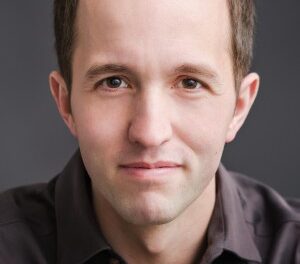It was in the Ernest W. Nelson Music Room, one of the region’s most wonderful small concert venues, acoustically, that, under the auspices of Duke Performances, the Ciompi Quartet*, Duke’s own, gave its final subscription concert of the 2010-11 season.** The program embraced 18th-, 19th-, and 21st-century music, and the overall results were, in a word, stimulating.
Mozart’s last three quartets, the so-called “Prussian” series, differ stylistically from most of the master’s other works in this form, being, as Fred Raimi’s program note reveals, “more soloistic and graceful [and] less dense in motivic development.” The penultimate work in this series, in B-flat, K. 589 (listed as Quartet No. 22), is one of Mozart’s most charming and ingratiating scores – which is saying a lot, given the composer’s universal appeal. It was a particular delight to experience this music in this room at the hands of these seasoned artists, musicians who have matured as an ensemble together (and otherwise, too – for example, all four now wear glasses!) and who play so wonderfully together. The clarity and definition they exhibited here could hardly have been bettered, and that’s a fact, even in the context of all the great visiting ensembles Duke hosts every year. Here and there, there may have been a bit too much clarity, for a periodic fifth voice was at times apparent – Raimi clearly loves this music and he sang a bit, in the manner of Toscanini (but with a much better voice, for sure).
Next up was the fourth performance of a new (2010) work by young Duke Music Department composer John Supko (b.1980), whose Ph.D. from Princeton (2009) is but one of many seals of approval he’s garnered. Inland Ocean is a quartet with computer-assisted/generated electronics that turned out to be a considerable production number, involving a larger supporting cast than just about any quartet I can recall. There was the Ciompi Quartet, of course, playing amplified instruments. There was the composer and an assistant, seated at a centrally-positioned laptop. There was, in a balcony, the programmer who had helped set up the machine. And there was a stagehand, DP Director Aaron Greenwald (on this occasion), who propped the large scores/roadmaps (five feet wide, someone said) on double music stands for the players. (There were also three pages of program notes that were at first encounter, like the music, only moderately comprehensible.)
The work was sparked, in part, by the poetry of Kenneth Koch and is heavily laden with literary influences, some fed through a Markov chain (about which one may read online, starting with http://en.wikipedia.org/wiki/Markov_chain) before reaching, via some technical wizardry, a manipulatable computer that (somewhat) randomly kicks off (verbal and other) cues that tell the musicians what to play next and when to move on to another of the 18 separate keyed musical sections. Presumably the parts for the four artists are integrated to create some semblance of unanimity within each section but the overall effect on first hearing suggested John Cage of the “Variations” period in which ambient and accidental sounds formed, with not too much human intervention, a swath of sound. All this means of course that no two performances are ever going to be even approximately the same, although one suspects some minor interventions to achieve what Thomas Beecham said was an essential ingredient of any performance – the requirement that musicians start and end together. There was certainly that in Nelson at this concert, as the machine kicked things off and as Pritchard played a quite glorious high violin solo of an unexpectedly sentimental strain as the piece reached its conclusion. (I should have gone to the first course presentation on Thursday to preview it and hear the composer’s remarks about what makes it tick.)
There was nothing troubling about any of this, and there was nothing that was off-putting, but I am not convinced that the randomly-generated reactions from the audience, responding to randomly-driven bits of computer-enhanced text and musical fragments, tell us much about the meaning of this piece in particular or its place in the overall scheme of our intellectual life. Clearly a rehearing or two or three will be required before one can set it in its proper context. One thing, however, is clear at the outset: the labor-intensive requirements of technically-overloaded works like this in and of themselves militate against frequent performances.
During the intermission there was some grousing, some confusion, and some bewilderment among the crowd. But there was none of that by the time the concert ended, thanks to a glow-from-within reading of Brahms’s String Quartet No. 2, in A minor, Op. 51/2. The artistic leader of a distinguished local ensemble commented that we hear these Brahms quartets too rarely; the reason, it seems to me, is their musical complexity and their moments of psychological darkness. But here again great clarity and light suffused the fabric of the score. Even rabid 19th-century Wagnerians – the folks who were so thoroughly in Richard’s camp they had no room for Johannes Brahms – would have seen and felt the Rheingold-like radiance coming from the heart of this performance. The artists found just the right sonority and just the right blend of contemporary precision with old-school expression. The place erupted with applause, and animated discussions spilled over to the post-concert reception downstairs.
*The members are Eric Pritchard and Hsiao-mei Ku, violins, Jonathan Bagg, viola, and Fred Raimi, cello.
**Two performances remain – on April 5, at noon, in the Rare Book Room of Perkins Library, and on April 17, at 3:00 p.m., at the NC Museum of Art, the latter a memorial concert for Maxine Swalin. For details, see our calendar.











